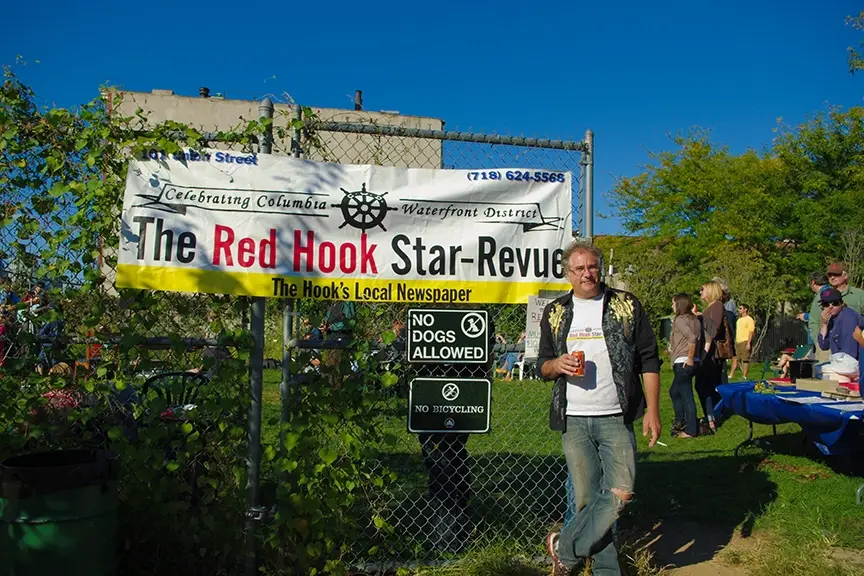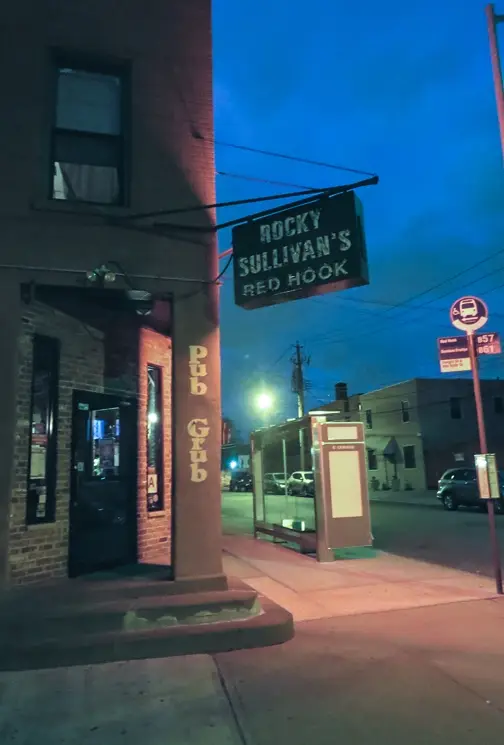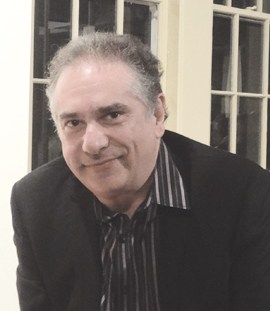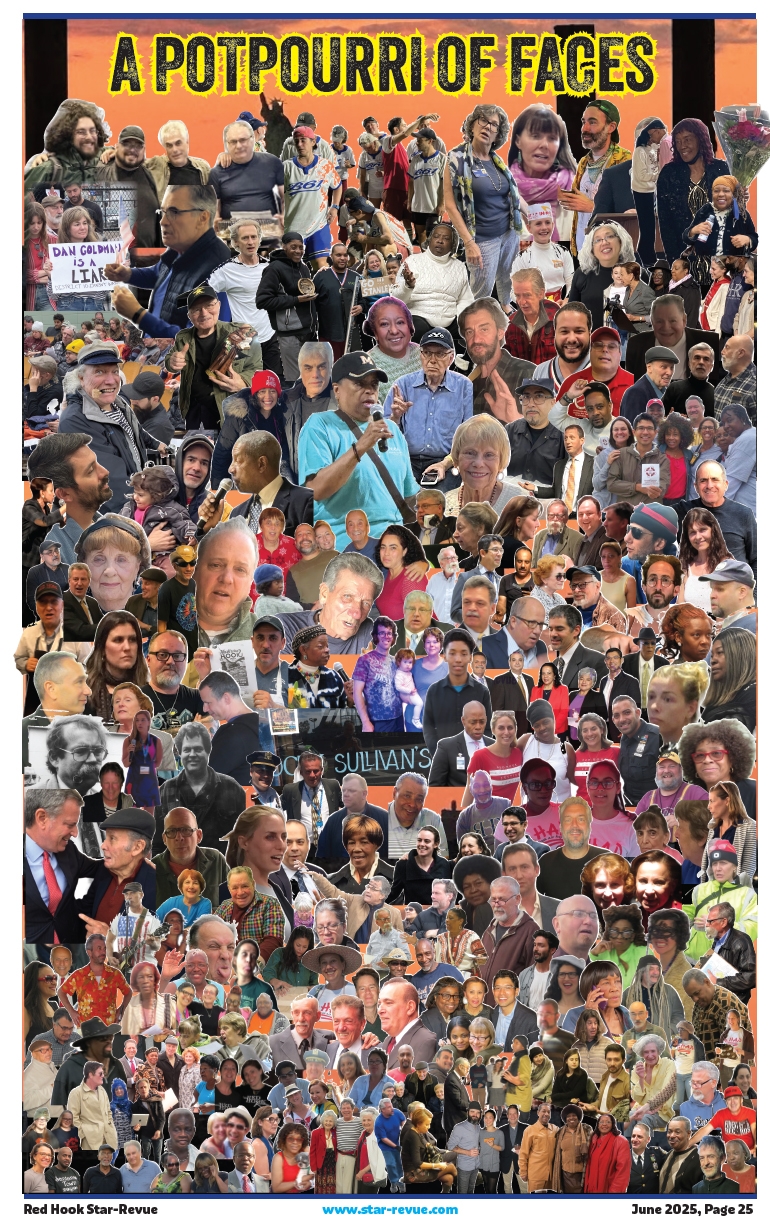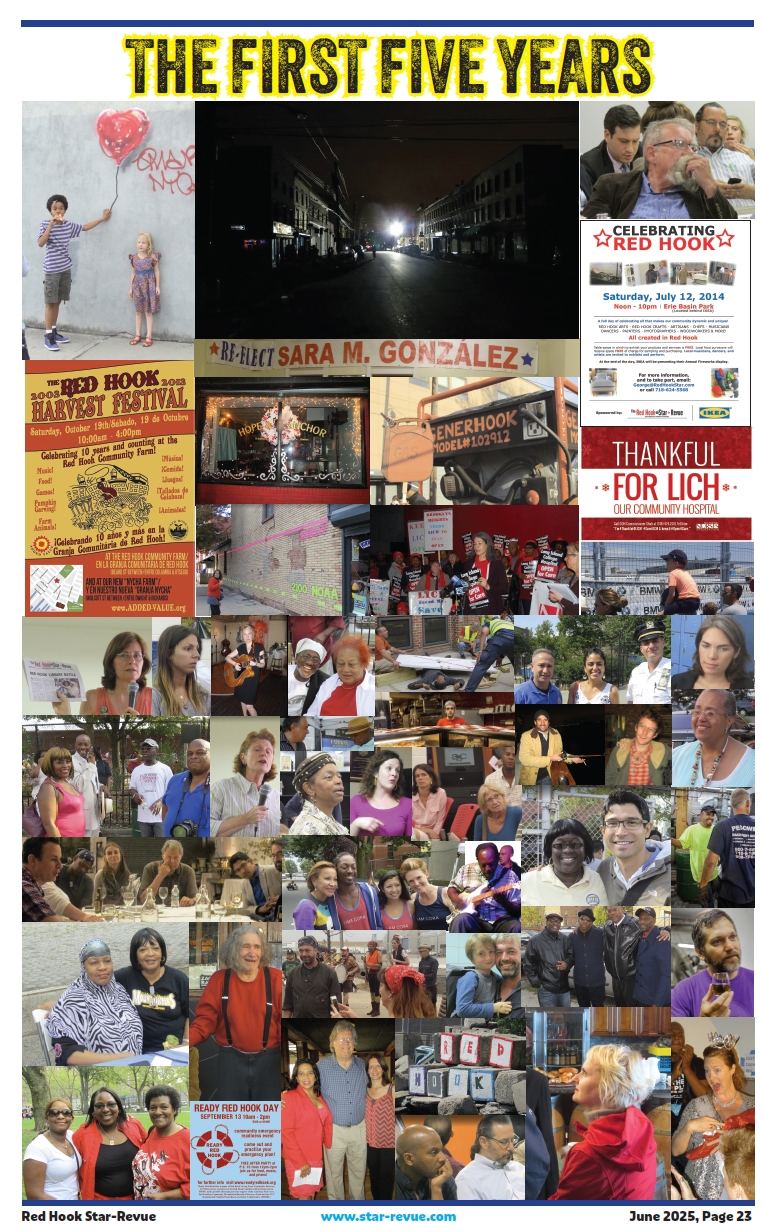What doesn’t kill you makes you stronger, the trite expression goes. I may not be stronger, but I still love putting together this paper every single month.
I’ve never actually lived in Red Hook, but I’ve been on its fringes ever since I moved to Boerum Hill in 1983.
My very first Red Hook memory was in 1978 when I borrowed my boss’s car to go to a friend’s bachelor party in New Jersey. It didn’t have a working gas gauge, and I ended up running out of gas in the Battery Tunnel during rush hour. It was a mess, and when TBTA towed me out they took me to their little house on Hamilton Avenue to figure out what to ticket me for.
There was one time during one of the dark days of my divorce that I wanted to drive to someplace that was even worse shape than me. I ended up at the end of Van Brunt Street, to an old barbed wire fence surrounded with garbage. I looked through the metal openings and was pretty surprised when
I saw the Statue of Liberty.
“What is she doing there,” I thought.
I would have never thought that 40 years later I’d be passing through there every day on my way to work.
By the 1990’s, many Brooklyn neighborhoods were on their way up experiencing what became known as gentrification. Brooklyn Heights was always pretty affluent, followed by Cobble Hill, Boerum Hill and Park Slope. But when places like Williamsburg, Astoria and Dumbo turned into hip epicenters, everyone thought Red Hook would be next. But as late as 2006 I remember wondering when that would be. But then IKEA opened, followed by Fairway, and then Hope and Anchor, Lillies and LeNell’s, not to mention Sunny’s, and Red Hook was on the way up.

Union Street
In 2010 I moved my mailing business to 101 Union Street, between Columbia and Van Brunt. It had a more space than I needed for the business so I decided to add a stage and a cafe and made lots of trips through Red Hook over to IKEA to get it furnished. Little by little I became intrigued by the neighborhood. Having both housing projects and gentrifiers made me think that there must be a lot of interesting stories here, and in June I published the first issue.
We got some publicity almost immediately when I assigned a story about the food truck parking lot I noticed on Degraw Street. Food trucks weren’t yet that popular here in the city and our story got picked up someplace. Oh boy, I’m in business, I thought. I kind of thought our local reporting would get picked up often by the bigger media, but it hasn’t happened. I’ve actually been disappointed that the reporting we’ve done over the past year about the local unhappiness with the city’s plan to put skyscrapers in our sleepy neighborhood, but that story hasn’t really broken through.
One hot summer day I was walking up and down Van Brunt trying to sell a few ads when I walked into Hope and Anchor. I never really got to know Pete Ascolese, who was a local restaurant pioneer, but I’m thinking that it was he who asked me whether the paper was distributed to the Red Hook Houses. To be honest, I don’t remember if I did. When I said that we went to an affluent audience he said he wasn’t interested. At first I thought it was just a brushoff, but after thinking about it I realized that a real community paper has to go to the whole community.
Life magazine
So I started to make sure we covered all of Red Hook. It was easier in those days, because the tenant associations allowed us at their meetings (that has changed following the defeat of longtime TA President Lillie Marshall).
In 1988, in the midst of the crack epidemic, Life Magazine came to the Red Hook Houses and wrote an article called The Death of a Neighborhood. I bought a copy on eBay and decided to do a follow-up. One of the people still around from those days was Bishop Tucker, who still led the New Breed Church on Lorraine Street. I interviewed him for the article, and will never forget him sitting on a golden throne inside. He attributed a lot of improvements to the establishment of the Red Hook Justice Center, a court with a heart that still thrives on Visitation Place.
We established a great relationship with Judge Calabrese at the Justice Center, a very special man, but unfortunately, since he retired we rarely hear from the Center, although the court officers are very friendly when we drop off the papers there.
Khary Bekka
Speaking of justice, a number of years ago we started getting letters from a prisoner at Sing Sing. Khary Bekka was serving a 25 year to life sentence for his involvement in the death of PS 15 principal Patrick Daly. Daly was walking a student home when he was hit by a stray bullet in Coffey Park. This was in 1992, and the death made citywide news and helped spark Red Hook’s eventual revival.
Kimberly Price, Matt Graber and myself went up to Ossining a couple of times and met Bekka, who had been spending a lot of time writing books on African and America history. We put him on our mailing list and he loved reading news from home. He eventually starting writing some columns for us, and one of the things I am most proud of is that he put his clips in his parole request which was finally granted. He came to visit and I took him to the Justice Center and introduced him to Viviana and Andrea because I thought he would be a great mentor to today’s troubled kids. He also became a Quaker and made a good life for himself after that rough beginning. Which, by the way, would never had been rough had he been born in a middle class Park Slope family. He’s pretty smart and would have been playing with video games rather than with guns.
The summer of 2011 brough us Hurricane Ida. We used to run music jams weekly at 101 Union Street, through which I met a ton of musicians. Putting together a music festival is just the kind of thing I like to do, and so I planned a Star-Revue festival at the Urban Garden, across from the Red Hook Container Terminal. For the first time in my life, I started checking out the ten day weather forecast. As it got down to five days before the scheduled fest, some scary news began appearing – a potential hurricane. By the day before I was forced to postpone the fest as a full fledged hurricane was guaranteed. I spent the night in our office, which had a leaky roof, and emptying the buckets were the worst thing that happened, as Ida ended up simply a hard rain.
I went to Van Brunt Street in the morning to take a picture of damage, and the worst thing I saw was a sunflower plant bent over across from Hope and Anchor. I ended up running that photo in the paper, and running the festival the next weekend.
Sandy
We weren’t so lucky a year later. In the week before Halloween the news started reporting on a kind of crazy hurricane that might actually have snow. I think they called it a bomb hurricane. Thinking of Ida, I didn’t really take it all that seriously. The big story that week was a community board meeting about a halfway house that was planned for the Carroll Gardens side of Hamilton Avenue. The PS 58 auditorium was full and there was a heated debate as most didn’t want ex-prisoners in their neighborhood. That never happened.
But of course, the next Monday a much bigger story happened. That day was spent putting tape on all the windows on Union Street, as my co-publisher grew up in the South and was well aware of Katrina.
In the evening we went up Van Brunt as the rain started. I remember standing on Coffey Street watching water come down the street. As the stream started becoming a river, and went to move the car, which was a very smart thing to do – as so many got their cards flooded and destroyed that evening. I parked near Hamilton Avenue and as it got dark the water really got high – over there the water came from both south and west. Over by the terminal gate on Conover the water was over my head, but just a couple blocks away, by the Chase Bank, there was hardly a puddle. Our block, Union between Van Brunt and Columbia, was also left high and dry. In fact, we suffered no loss of electricity or internet, yet just a short walk away, across Hamilton Avenue, most of Red Hook was left with no electricity or internet for days – the Red Hook Houses were out for three weeks.
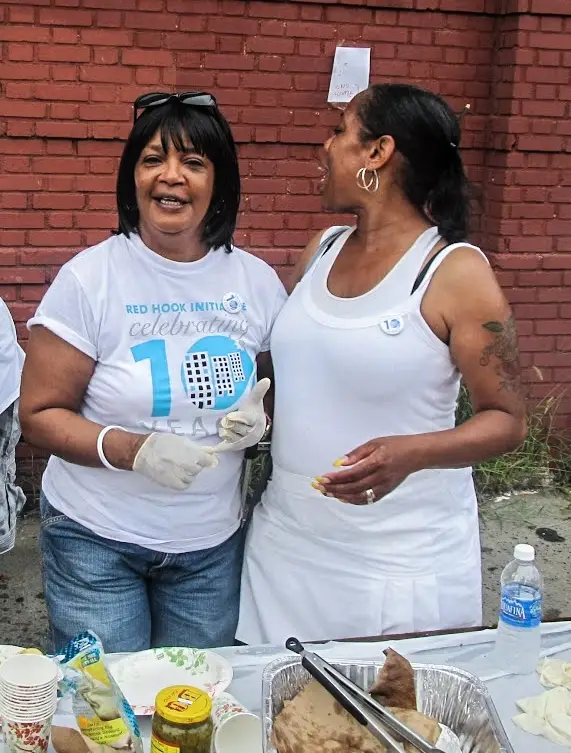
The aftermath
Red Hook received worldwide attention following the storm. The only other time I saw that happen was when the owner of Dell Cherries shot himself to death while undergoing a police inspection, knowing that his huge basement marijuana crop was about to be discovered.
Sheryl Nash-Chisholm was the one person at the Red Hook Initiative who became a real friend. RHI became one of the main conduits of relief funds in the neighborhood, at one point so much money was coming in that they ended up sending extra to the needy in Coney Island. Sheryl told me how it started.
She came to work the next morning and found that the office, at Hicks and West 9th, suffered no damage. As she opened the door the phone was ringing. She picked it up and it was someone from Maryland who heard what had happened and wanted to help. Sheryl took down his number and called her boss, Jill Eisenhard to see what to do. Jill said of course we can help and told her to call the guy back.
I would say that RHI grew in all sorts of ways that year as they took a major role in collecting and dispensing money for the community. It probably would have happened anyway, but I’ve always wondered what would have happened had Sheryl done what many would do, which is to take the day off.
I was made to leave the neighborhood against my will, (for safety reasons), but as soon as it got light came back to an amazingly changed neighborhood. Fairway’s doors were smashed in by the water, a boat was swept ashore on Beard Street, trees were knocked down in Coffey Park and paint from an artist’s studio on the pier colored the concrete boardwalk red, as well as the bulkhead below.
It turned out a lot of the flooding was due to the high tide, and as the tide went in the water receded, but the end of Van Brunt was still flooded that next morning.
For the next few years, resiliency was the main word, and the effects are still happening. There is supposed to be a Red Hook Coastal Resiliency program happening, but much of that is still undone. The Red Hook Houses were granted FEMA money to make sure that they are better prepared for the next disaster, but a lot of that work is still happening, although it looks like possibly the end is in sight.
And if the Brooklyn Marine Terminal Luxury Housing project gets approved, climate change combined with rising sea levels may be our only hope to defeat them in court.
Rocky Sullivan’s
A lot of the damage took a while to be noticed. Rocky’s, a bar which had relocated to Red Hook from Manhattan 2007. It had been near Paddy Reilly’s, famous for weekly gigs of the Irish punk band Black 47, and one of it’s owners was Chris Byrne, a founding member of that band.
One day I was at the bar and they couldn’t pour beer from a particular tap. George Kornienko, one of the best bartenders in the world, explained to me that when they were flooded, the water was salt water, and while they cleaned up right away and things were working, over time the salt started degrading the metal. The same thing, by the way, happened to some of the trees in Coffey Park that had to be chopped down, much to the chagrin of many parkgoers.
George was one of the few in the neighborhood who had that old fashioned respect for newspaper people. The others included Buddy Scotto and Sunny Balzano.
All are sadly gone, and George was an unbelievable and unexpected loss. And he was only 52. Rocky’s, along with the Ice House, were the two places that I knew of that were equally welcoming to all the people in the neighborhood, and was always ready to give a free meal to someone who needed one.
When I had to move my office and couldn’t run my music jams anymore, he let me move them to Rocky’s, which had the added benefit of hot pizza.
I ended up writing his obituary in 2017, which included this:
“Anybody who has had the good fortune to know George Kornienko these past ten years, since Rocky’s moved to Red Hook from Manhattan, know what I am talking about. In a time when humility is almost a lost attribute, George was humility personified. I just looked up a phrase that comes to mind, although I didn’t exactly know what it meant – self-effacing. It turns out I had the correct idea: “not claiming attention for oneself; retiring and modest.”
I will always remember George for being one of the first people to welcome me to this community when I started the Star-Revue back in 2010. Rocky’s made its name as a writer’s bar, originally.
Our fourth issue, September 2010, featured a review of Rocky’s. In it, our reviewer described George as gracious. They also mentioned that he was excited that his plans for a winter street-hockey tournament outside the bar was finalized. George could get excited over lots of things – especially sports.”
The waterfront
Before I knew the neighborhood, I made a trek to Lillie’s, which was actually a bar at Rocky’s second Red Hook location, and now houses Lundy’s, the new-old restaurant.
I went because somehow I heard about a musician I wanted to hear was playing there. (By the way, the stage she played on is still there). That was before IKEA was built, and I remember the big green fence all along Beard Street. I also remember that somebody told me it was near the water, but the fact that Red Hook is surrounded by water confused me. Yes, we used to drive before there were GPS’s and cellphones.
One of the first big stories I covered for the paper was when the Port Authority booted Sal Catucci, the owner of the Red Hook Container Terminal. It seemed like some kind of scandal, although nobody at the Port Authority would talk to me. I finally met Sal last month and he confirmed what I wrote, that he was booted for non payment of rent; that he didn’t pay the rent because the Port
Authority stopped applying for federal grants for barging, needed to run a succesfful terminal there and so he had to use the rent money to pay the barging himself. What I didn’t know was that he was told not to pay the rent by a politician, who, by the way, is still around and a voice for the waterfront, that he would straighten everything out and he’d get the grant back which will cover the rent.
That didn’t happen, and Sal was booted. What he told me that the Port Authority was actually trying to get rid of the terminal the whole time he was there, since 1992. The reason was, as I recently heard the current owner say, because of the damn view. Luxury water views of Manhattan and the Statue of Liberty bring a lot more dollars than the rent a maritime facility will pay.
Sal told me that the city will win and we will lose the waterfront to skyscrapers unless the whole neighborhood unites against it.
One trick the Port Authority has used to undermine the marine terminal is granting only short term leases. Sal managed a ten year lease before he left, but it seemed unlikely to be renewed. Mike Stamatis, who runs the terminal now, has said that without a 30 year lease, he cannot arrange necessary financing to operate profitably. The current EDC plan has left him hanging. A task force member, he is pretty much obliged to support the luxury housing plan, which ostensibly would provide that funding. Yet even if the plan is approved on June 18 by the Task Force of which he is a member, he is not even guaranteed to stay, as the new master plan would put everything out to bid, including his Red Hook Container Terminal.
The same thing goes for the ILA, who is also a member. The EDC threat is that without approval for housing, they would abandon the terminal, causing loss of all their jobs here. So that’s another forced yes vote for housing.
The paper above speculated that a move to Sunset Park was being worked on. In retrospect I don’t think I was wrong to think that – there are ILA members now working in Sunset Park assembling parts for the offshore wind project.
For those who may remember the old Dennison radio commercials stating “Money Talks, Nobody Walks,” lets hope that’s not the end of Red Hook.
Author
-

George Fiala has worked in radio, newspapers and direct marketing his whole life, except for when he was a vendor at Shea Stadium, pizza and cheesesteak maker in Lancaster, PA, and an occasional comic book dealer. He studied English and drinking in college, international relations at the New School, and in his spare time plays drums and fixes pinball machines.
View all posts
George Fiala has worked in radio, newspapers and direct marketing his whole life, except for when he was a vendor at Shea Stadium, pizza and cheesesteak maker in Lancaster, PA, and an occasional comic book dealer. He studied English and drinking in college, international relations at the New School, and in his spare time plays drums and fixes pinball machines.
Discover more from Red Hook Star-Revue
Subscribe to get the latest posts sent to your email.

